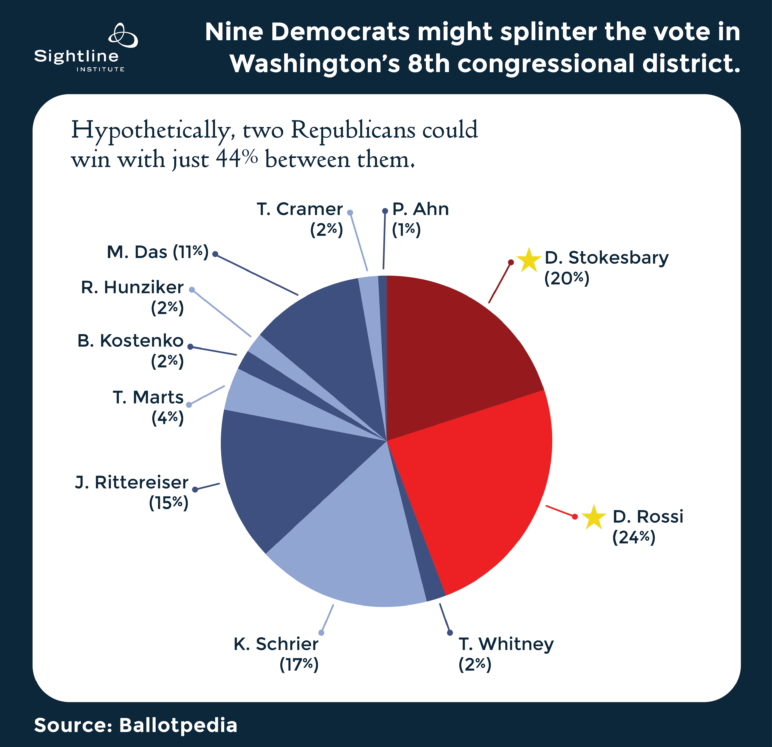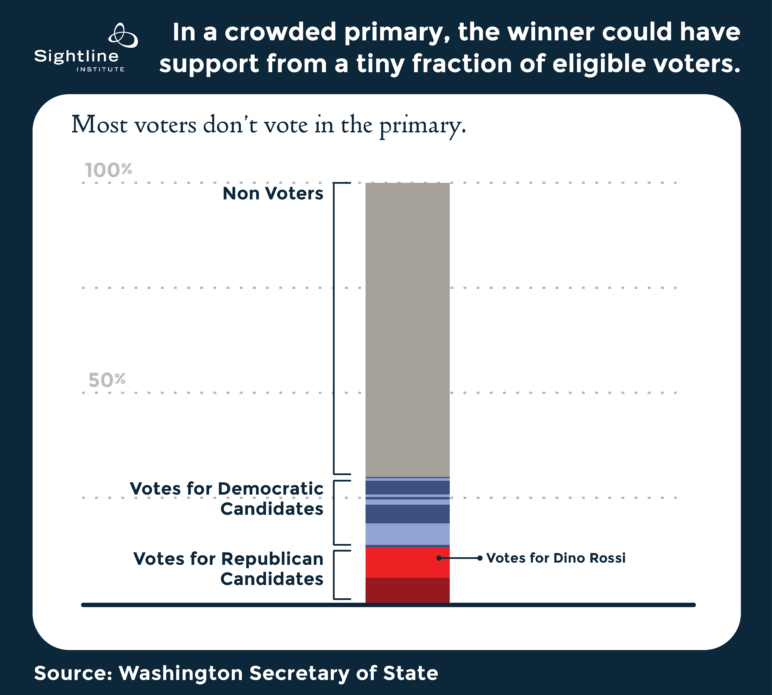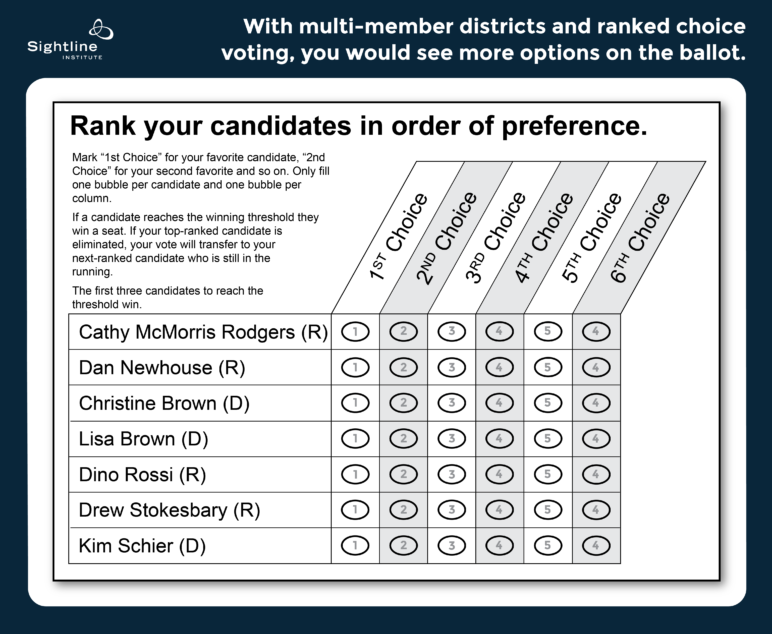Washington’s Top Two open primary system—in which all voters get to choose their favorite candidate, regardless of party, and the top two candidates, regardless of party, advance to the general election—is an improvement on the systems that other states use. All Washingtonians can vote in every primary, while Oregon’s closed party primaries disenfranchise the more than one-third of voters who aren’t registered with one of the two major parties. Top Two primaries also prevent vote splitting in the general election. If the US Presidential elections used Top Two primaries, a third-party candidate like Nader would not be able to split votes with a major party candidate like Gore.
But, unfortunately, Top Two is still vulnerable to vote splitting and unrepresentative results. Take the race shaping up right now in Washington’s 8th congressional district.
Vote splitting could yield an unrepresentative result
Washington’s 8th congressional district, stretching from Seattle’s eastern suburbs to Wenatchee, is a swing district. Between 2004 and 2010 voters elected centrist Republican Dave Reichert by less than 53 percent. The 2010 redistricting process re-shaped the district, making it much more conservative, and in 2016 Reichert won handily, but at the same time the district narrowly went for Democrat Hillary Clinton. At the beginning of 2017, the Democratic Party identified the 8th district as a target race it could win. In September, Reichert announced he won’t run again.
Nine, yes nine, Democrats have announced their campaigns for 2018. So far, just one Republican, Dino Rossi, has announced. But imagine what could happen if the Republicans field one more candidate. (In the figure below, which is purely hypothetical, with real candidates and made-up vote totals, I inserted state representative Drew Stokesbary.) Voters could prefer a Democratic candidate to a Republican 56 to 44, yet because the Democratic vote splits nine ways, two Republicans could win the primary. The Republicans would then be guaranteed to win the seat, even though voters preferred a Democrat.

Given that only about 30 percent of registered voters turn in ballots in mid-term primary elections, as few as 7 percent of all registered voters could choose Dino Rossi in the primary. If a not-yet-announced Republican (such as Stokesbary) got 20 percent of the primary vote, equal to 6 percent of all registered voters, both could advance to the general, and despite winning a tiny fraction of the votes in the district, a Republican would be the sole representative for 100 percent of constituents.

This isn’t just wild imagining; a similar thing happened in the 2016 Washington race for State Treasurer. Though Washington leans Democratic, general election voters had no option to vote for a Democrat for Treasurer. In the primary, most voters preferred a Democrat, but they split their votes among three Democratic candidates—Marko Liias garnered 20 percent, John Paul Comerford 18 percent, and Alec Fisken 13 percent. Only 47 percent of voters preferred a Republican, but there were only two Republican candidates so Duane Davidson got 25 percent and Michael Waite 23 percent.
A different voting method could work better
Now imagine instead that Washington allowed voters to rank more than one candidate. Instead of your vote for, say, Mona Das, being thrown away along with all the other votes for Democratic candidates, if she was eliminated, your ballot would stay alive and count for your next-ranked candidate who was still in the race, maybe Kim Schrier. Counting would (instantly) continue in rounds until voters had consolidated upon the two most popular winners, probably one Democrat and one Republican.
Even better, imagine Washington elected more than one representative from a multi-member district. It could be a five-member district like the national Fair Representation Act proposes. Or it could be a three-winner district combining eastern Washington’s 4th, 5th, and 8th districts. The primary would narrow the field to seven candidates running for the three seats, and in the general you might see a ballot like this:

You could rank your candidates in order of preference, and the top three would win a seat. Most likely, two Republicans and one Democrat would win, giving a fairer voice to voters in that region.
Don’t split votes
To prevent vote splitting in the 8th congressional district race, six or seven of the Democratic candidates need to take one for the team and pull out of the race. A disheartening prospect for both candidates and voters.
Or Washington could free candidates and voters from the constraints of plurality voting by using ranked ballots. Candidates could run if they want, voters could vote for who they want, and vote splitting wouldn’t spoil the results.
[list_signup_button button_text=”Like what you|apos;re reading? Get our latest democracy reform research right to your inbox.” form_title=”Reclaiming Our Democracy ” selected_lists='{“Reclaiming Our Democracy”:”Reclaiming Our Democracy”}’ align=”center”]


Comments are closed.